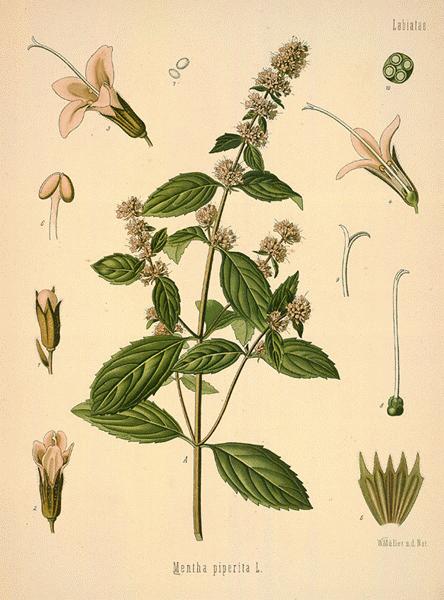The mint family contains 25 species and numerous natural hybrids. Although native to Mediterranean countries and western Asia, many varieties are now cultivated all over the world.
These include water mint (Mentha aquatica), field mint (M. arvensis) and spearmint (M. spicata). However, peppermint (M. piperita) - thought to be a natural hybrid between water mint and spearmint - is regarded as superior for medicinal purposes because of its high menthol content.

There are two forms of the plant - 'white' peppermint (with bright green stems and leaves) and 'black' peppermint (with purple stems and dark green leaves tinged purple-brown). Black peppermint yields the highest concentration of essential oil and is flavoured variety for commercial cultivation.
From Ancient Egypt on
The ancient Egyptians were probably the first people to cultivate peppermint - the remains of the dried leaves from a bouquet have been found in a tomb dating from about 300BC. According to hieroglyphics found in the temple of Edfu, mint was also an ingredient in their sacred incense formula, kyphi. However, the generic name of the plant, Mentha, is thought to derive from the Greek and Roman myth in which Minthe, a beautiful nymph, was pursued by Hades (Pluto in Roman mythology), god of the Underworld. Jealous Persephone found out that her husband's infidelity and turned Minthe into a herb to be trampled underfoot. Other sources report that the name derives from the Latin mente, meaning thought.
Certainly, varieties of mint were frequently mentioned by Dioscorides, Hippocrates and Pliny as strewing herbs which could dispel foul odours and prevent the spread of infectious disease. The piercing aroma of peppermint has always been credited with the ability to clear the mind and help concentration. Pliny (23-72AD) declared that 'the very smell of it alone recovers and refreshes the spirits'.
The Greeks and Romans used teas made from the herb to scent their bath water and as a general restorative. They also used peppermint as a medicine for flatulence and headaches. And for centuries the Arabs have taken peppermint tea to stimulate their virility and as a social drink. By the 14th century peppermint essential oil was being incorporated in substances to whiten teeth, and later in mouthwashes to mask the smell of tobacco.

According to John Gerard, the renowned Elizabethan herbalist, the smell of mint 'rejoiceth the heart of man'. He also considered it a 'good posie for students oft to smell', and especially beneficial for those of a weak constitution.
The Potency of Menthol
Peppermint oil is produced mainly in the USA, France, Bulgaria, Morocco, China and Japan, by steam distillation of the plant's flowering tops. The oil is colourless to pale yellow with an intense aroma - at first cooling and refreshing, and then giving way to a sensation of numbness. The oil owes its cooling and local anaesthetic effects to the aromatic compound menthol.
Unfortunately, most of the oil available has had a proportion of the menthol removed, as this is widely used by the pharmaceutical industry. Whole peppermint oil is much more expensive, and so seldom used in commercial products. Quite apart from its superior therapeutic properties, the whole oil has a more interesting aroma. Menthol on its own is extremely potent and has a higher risk of provoking skin reactions and respiratory problems in vulnerable groups.
Therapeutic Properties
Modern research confirms the therapeutic value of peppermint, which is best known for its beneficial action on the digestive system - hence the tradition of after-dinner mints and liqueurs. Peppermint tea makes an effective remedy for nausea, indigestion, heartburn and flatulence, and helps to relieve stomach ache and colic. The tea also acts as a pick-me-up and can alleviate tension headaches. The oil, taken internally in capsule form, can be an effective remedy for irritable bowel syndrome.
Externally, diluted peppermint oil can be used in pain-relieving balms and massage oils. Its menthol content is cooling to skin and muscles. It's also a mild local anaesthetic. Cold peppermint oil compresses can help reduce bruising, muscular pain and swelling from an injury. Applied to the forehead and temples, a compress can banish a headache, and migraine if used at the onset. A few drops inhaled from a tissue can alleviate mild indigestion as well as headaches.
Peppermint oil steam inhalations are good for catarrh and blocked sinuses, and for cold and flu symptoms. Steam your face with peppermint oil to cleanse oily skin with spots and blackheads. Or apply a warm compress soaked in tolerably hot peppermint tea. Used in moderation, peppermint can treat inflamed skin conditions and is a beneficial ingredient in home-made aftersun lotions. Vaporise in a burner for a quick fix for mental fatigue: its refreshing and piercing aroma will swiftly awaken the senses.